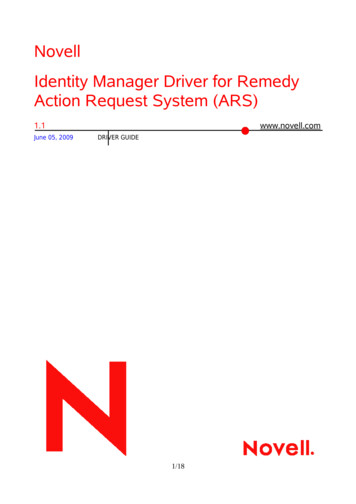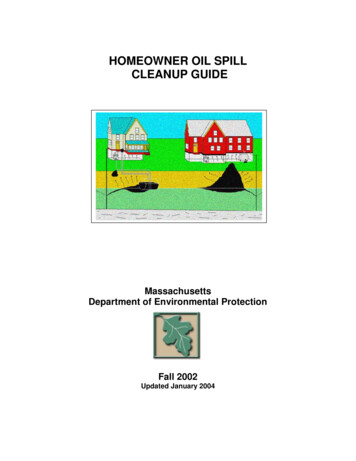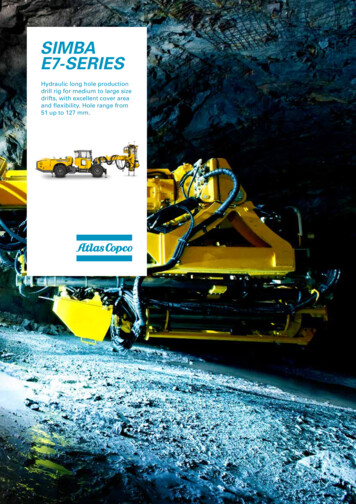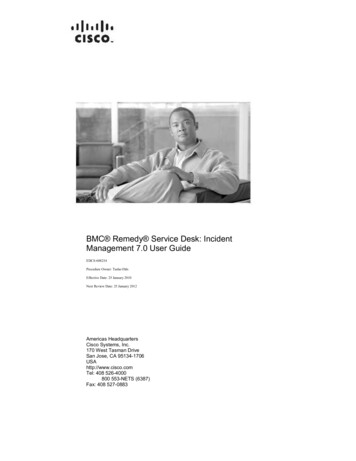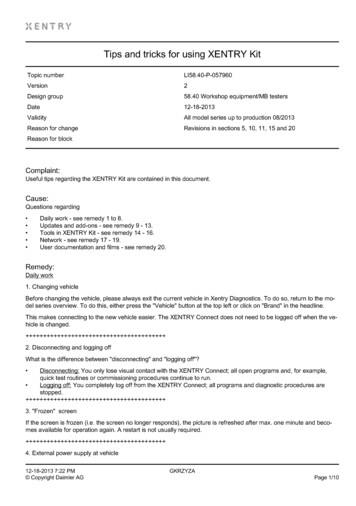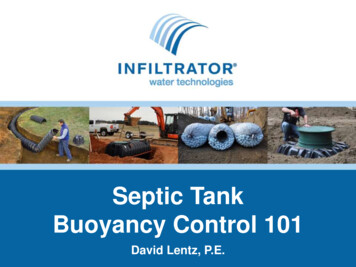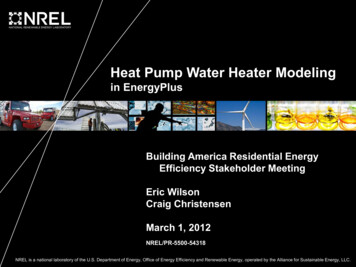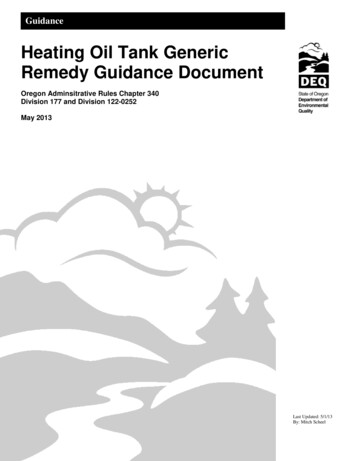
Transcription
GuidanceHeating Oil Tank GenericRemedy Guidance DocumentOregon Adminsitrative Rules Chapter 340Division 177 and Division 122-0252May 2013Last Updated: 5/1/13By: Mitch ScheelOregon Department of Environmental Quality
This report prepared by:Oregon Department of Environmental Quality811 SW 6th Ave.Portland, OR 972041-800-452-4011www.oregon.gov/deqContact:Mitch Scheel503-229-6704For “property transaction”, “expedite” or “rush only” processing of this fileplease use this address:Department of Environmental QualityNorthwest Region – HOT Program2020 SW 4th Ave., Suite 400Portland, OR 97201For all other transactions regarding this file please use this address:Department of Environmental QualityAttention – Revenue Section811 SW Sixth Ave.Portland, OR 97204
Heating Oil Tank Generic Remedy GuidanceTable of ContentsAcknowledgements . ivBackground Information .1Additional Information .2Definitions .2Section 1 – Steps For Using The Heating Oil Tank Generic Remedy Guidance.3Section 2 – Qualifying Criteria .5Section 2.1 – Diagram .6Section 3 – Cleanup Alternatives .7Cleanup Alternative 1.7Cleanup Alternative 2.8Section 4 – Site Assessment.9Section 4.1 – Free Product Assessment.9Section 4.2 – Groundwater Assessment .9Section 4.3 – Magnitude and Extent of Contamination .10Section 4.4 – Minimum Delineation Requirements .11Section 5 – Written Report Requirements .16Section 6 – Appendices .17Appendix 1 – Locating the Tank.18STEP 1 – Locate The Fill Pipe or Vent Pipe .18STEP 2 – Locate the Tank.18Appendix 2 – Decommissioning the Tank .19Why decommission heating oil tanks? .19Safety precautions .19Permanent decommissioning of heating oil tanks .20Decommissioning in Place .21Disposal of tanks, piping and equipment .21Transportation of tanks.22Storage of used tanks.22Record keeping.22Guidance and reference documents .22For more information: .23Appendix 3 – Sampling And Analysis – Excerpts From OAR Chapter 340, Division 122 .24Appendix 4 – Contact Information for DEQ Regional Offices .28Appendix 5 – Blank Forms for Optional Use .30Oregon Department of Environmental Quality5/1/13
AcknowledgementsThis document, Generic Remedy for Cleanup of Petroleum Contaminated Soil from Releasesfrom Residential Underground Heating Oil Tanks, was originally developed in 1999 by theHeating Oil Tank Generic Remedy Workgroup. Members included:Michael Anderson, DEQ, Waste Management DivisionRon Bergeson, Bergeson-Boese & AssociatesJim Glass, DEQ, Western Region UST Cleanup ProgramRon Goodman, Goodman Bros., Inc.Laurie McCulloch, DEQ, UST ProgramMitch Scheel, DEQ, Northwest Region UST Cleanup ProgramKaren White-Fallon, DEQ, Western Region UST Cleanup ProgramChris Wohlers, Wohlers Environmental Service, Inc.Additional review was provided by managers and staff of DEQ’s Underground Storage Tankprogram. Members of the public were invited to review and comment on the Sept. 1, 1999 draftof this document. Comments were received from four interested parties. Their suggestions wereconsidered and incorporated where appropriate into this final document.Background technical documentation for this generic remedy is contained in a separate report,Developing Risk-Based Standards for Residential Heating Oil Tanks // Heating Oil TankGeneric Remedy Addendum – Generic Risk Assessment Documentation, September 1999.ApprovalThis guidance document has been approved for use by the Oregon Department of EnvironmentalQuality Land Quality Division. signed by Mary Wahl, Division AdministratorOregon Department of Environmental QualityJanuary 24, 2000Original Date Approved5/1/13
Heating Oil Tank Generic Remedy Guidance1Background InformationOregon Administrative Rule 340-122-0252, adopted in November 1998, allows for thedevelopment and use of a generic remedy for the cleanup of common categories ofcontaminated sites. The rapid increase in the number of releases reported from residentialheating oil tanks over the past several years has made this category of sites an excellentcandidate for development of a generic remedy guidance document.A generic remedy that includes risk-based concentrations must be based on a generic riskassessment that documents DEQ’s conclusions, with respect to how sites eligible for useof the generic remedy will achieve acceptable risk levels. This documentation is providedin a separate report titled Developing Risk-Based Standards for Residential Heating OilTank Sites // Heating Oil Tank Generic Remedy Addendum – Generic Risk AssessmentTechnical Documentation, September 1999. This document is available from DEQ bycalling 1-800-742-7878 (in Oregon) or 503-229-6170. You may view and download thedocument from DEQ’s website at www.deq.state.or.us/lq/tanks/hot/.This guidance provides a streamlined approach to site characterization and cleanup ofheating oil contamination by prescribing generic risk-based concentration levels and isdesigned for sites that meet the qualifying criteria outlined in Section 2 of this document.Some anticipated benefits of this generic remedy are: Cost savings for homeowners for analytical costs and/or contaminated soil removalexpenses.Faster and easier report preparation by service providers and more efficient reviewsby DEQ.Less contaminated soil moved from one location to another resulting in pollutionprevention activities such as avoiding transfer of volatile pollutants from soil to theair.DEQ developed this document to provide specific guidance on site investigation andremedial action activities as they’re related to implementing this generic remedy forheating oil releases. It is not intended to be general guidance on site investigations, riskassessments, compliance sampling or other related activities. Additional guidance may beneeded to ensure that all phases of the project have been completed in a manneracceptable to DEQ.Assumptions made in the development of this document were based on experience withtypical heating oil-contaminated sites where diesel #2 was the contaminant. DEQ maymodify this guidance document as new information becomes available.Oregon Department of Environmental Quality5/1/13
Heating Oil Tank Generic Remedy Guidance2Additional InformationThe generic risk assessment and resulting risk-based concentration levels found in thisdocument are based solely upon potential risk to human health. Implementation of thisguidance is based on the assumption that there are no unacceptable ecological risks fromthe heating oil found at the site. The qualifying criteria in Section 2 of this documentwere developed with this limitation in mind. Should potential ecological risks be presentat a specific site, further assessment of this potential risk will be required and use of thisgeneric remedy may not be applicable.This document does not supersede other applicable federal, state or local regulations,including but not limited to those specified in: OAR Chapter 340, Division 177- Residential Heating Oil Underground Storage Tanks OAR Chapter 340, Division 122- Cleanup Rules for Leaking Petroleum UST SystemsNote: Soil analytical test methods for total petroleum hydrocarbons are expressed in theunits “ppm” (parts per million) and “mg/kg” (milligrams per kilogram). These units areequivalent and used interchangeably throughout this document.DefinitionsAs used in this document:The term “contaminated soil” means any heating oil-affected soil where total petroleumhydrocarbon concentrations exceed 50 mg/kg NWTPH-Dx.The term “seasonal high groundwater level” means the shallowest depth from the groundsurface to the water table experienced in a typical year. This can vary considerably basedon which area of the state the site is located. In the wetter parts of the state this wouldtypically be measured during the winter or spring when soils have been saturated frommonths of rain. In dryer parts of the state, groundwater levels may not fluctuatesignificantly during the year.Oregon Department of Environmental Quality5/1/13
Heating Oil Tank Generic Remedy Guidance3Section 1 – Steps For Usingthe Heating Oil Tank GenericRemedy GuidanceThe flow chart on the next page provides the step-by-step procedures required for theselection and implementation of this generic remedy guidance.Oregon Department of Environmental Quality5/1/13
Heating Oil Tank Generic Remedy Guidance4Decommission the tank per OAR 340-177-0025 and applicable guidance inAppendices 1 and 2Was a releaseconfirmed?YESNORefer to OAR 340-177-0025 and340-177-0095 for decommissioningrequirementsReport confirmed release to appropriate DEQ regional office(see Appendix 4) within 72 hours per OAR 340-177-0055Conduct a site assessment to determine magnitude and extent of thecontamination in accordance with Section 3 of this document and Appendix 3Does site meetQualifying Criteria inSection 2?NOYESRefer to OAR 340-177-0065 foradditional cleanup optionsDoes site meetCleanup Alternative1 or 2 in Section 3?NOPrepare written report: Section 5 of this documentSubmit report to DEQ regional office per OAR 340-177-0095Oregon Department of Environmental Quality5/1/13
Heating Oil Tank Generic Remedy Guidance5Section 2 – Qualifying CriteriaIn order to apply this generic remedy to a heating oil contaminated site, you must meetall of the following criteria: The release is from an underground heating oil tank.While this generic remedy was developed for use on residential properties, it may beapplicable to commercial heating oil tank sites if all other conditions are met (youshould contact a DEQ regional underground storage tank staff for guidance prior toapplying the generic remedy to a commercial site); The only petroleum product that has been released at the site is heating oil(diesel #2).There should be no gasoline, solvents, used oil or other petroleum products beingcleaned up under this generic remedy. Contamination is limited to soil only with no groundwater detected in the tankcavity or in any soil borings. No free product is present as a result of the tank leak. The release poses no ecological risks.If the cleanup site does not meet these criteria, refer to OAR 340-177-0065 for othercleanup options available.Oregon Department of Environmental Quality5/1/13
Heating Oil Tank Generic Remedy Guidance6Section 2.1 – DiagramThe following diagram shows the conceptual site model for a generic heating oil tanksite. The reference to the size of the home (1200 sq. ft. or larger) is important as itpertains to calculations made in the generic risk assessment. Some recalculations may benecessary if the home is very small and vapor intrusion into the home from contaminatedsoil is likely.Oregon Department of Environmental Quality5/1/13
Heating Oil Tank Generic Remedy Guidance7Section 3 – CleanupAlternativesOnce it’s been determined that the site meets the qualifying criteria in Section 2 above,the next step is to determine if the site meets one of the generic remedy cleanupalternatives. For each alternative, the extent of the contamination must first be delineatedto a total petroleum hydrocarbon concentration equal to, or less than, 500 ppm by MethodNWTPH-Dx (DEQ, December 1996).Cleanup Alternative 1Each of the following elements must be met for this alternative to be appropriate. The maximum level of total petroleum hydrocarbon contamination remaining inresidual soil is less than or equal to 2,500 ppm. The volume of residual soil with total petroleum hydrocarbon contamination levelsequal to or more than 500 ppm does not exceed 65 cubic yards. There’s at least three (3) feet of non-contaminated soil above any contaminated soilremaining at the site. Contaminated soil remaining at the site is above the seasonal high groundwater level.Additional Notes: This alternative may apply to sites where the tank has been decommissioned either inplace or by removal. Under this alternative, contaminated soil removal may be used to meet the protectivelevel of 2,500 ppm TPH. The decision to remove contaminated soil to comply withAlternative 1, or to proceed with Alternative 2, should be made by the homeownerbased on cost or other personal preferences in consultation with the licensed serviceprovider.If site conditions are not appropriate for use of this alternative, the next step is todetermine if Cleanup Alternative 2 is appropriate.IMPORTANT: Any contaminated soil excavated and removed from the site must bedisposed of in a DEQ-approved landfill or treatment facility. Stockpiled petroleumcontaminated soil cannot remain on site for a period exceeding 30 days unless otherwiseapproved by DEQ. At all times, contaminated soil stockpiled on the site awaiting disposalor treatment must be kept within a secure area and adequately covered and bermed.Oregon Department of Environmental Quality5/1/13
Heating Oil Tank Generic Remedy Guidance8Cleanup Alternative 2Each of the following elements must be met for this alternative to be appropriate: The maximum level of TPH contamination remaining in residual soil is less than orequal to 10,000 ppm. Analysis for the presence of benzene, ethylbenzene and naphthalene must beperformed on all samples exceeding 2,500 ppm TPH. Concentrations for thecontaminant of concern cannot exceed the following: Benzene – 0.1 ppm. Ethylbenzene – 0.82 ppm. Naphthalene – 6.5 ppm. The volume of residual soil with TPH contamination levels equal to or more than 500ppm does not exceed 65 cubic yards. There is at least three feet of non-contaminated soil above any contaminated soilremaining at the site. Contaminated soil remaining at the site is above the seasonal high groundwater level.Additional Notes: Additional soil removal may be conducted and sampling repeated to meet thisalternative. Again, this is a decision the homeowner should make based on cost orother personal preferences in consultation with the licensed service provider. Under this alternative DEQ will also require an estimation of the distance from thesource of the contamination and any surface water feature within 100 feet. The protective levels (risk-based concentrations) referenced in this generic remedy,and the soil constituent of concern (benzene), along with the exposure pathways ofconcern (i.e. vapor intrusion into buildings and leaching to groundwater), aredescribed in detail in the document Heating Oil Tank Generic Remedy Addendum –Generic Risk Assessment Technical Documentation, September 1999.If site conditions don’t meet either of the alternatives above, use of this generic remedyfor heating oil cleanups is not allowed.Refer to OAR 340-177-0065 for other cleanup options available.Oregon Department of Environmental Quality5/1/13
Heating Oil Tank Generic Remedy Guidance9Section 4 – Site AssessmentA site assessment must be made to determine the source, nature, magnitude and extent ofcontamination associated with a release from an underground heating oil tank. This isnecessary for the purpose of applying this generic remedy. The site assessment mustgather sufficient information to demonstrate that the site meets: qualifying criteria outlined in Section 2 above , andrequirements for cleanup alternatives described in Section 3 aboveFor these reasons, the site assessment must specifically address: An assessment for the presence of free product An assessment to determine if groundwater is affected and the depth to groundwater The vertical and horizontal extent of heating oil contaminationSection 4.1 – Free Product AssessmentDetermining the presence of free fuel product is simple. If there’s a pool of liquid fuel inthe tank excavation, or clearly visible saturated soil, free product is present and use ofthis generic remedy is not allowed.If the free product is a direct result of a spill that occurred during the immediate tankdecommissioning work, this is not considered to be free product for the purpose ofdetermining if the generic remedy is appropriate for use. The spilled fuel must beimmediately removed from the excavation to avoid spreading the contamination.Note: If vapors or free product pose any fire or safety hazards, you must notify theappropriate DEQ regional office immediately.Section 4.2 – Groundwater AssessmentGroundwater Impact: To determine whether water encountered in the tank excavation isgroundwater, pump the water from the pit and dispose of it in accordance with allcurrently applicable requirements. This may require obtaining permits from DEQ or localjurisdictions. If the pit remains dry for 24 hours, sampling and cleanup may proceedunder the generic remedy. If water returns in less than 24 hours, it’s presumed to begroundwater and use of this generic remedy isn’t allowed.Note: If you encounter groundwater at any time during release identification or cleanup,you must notify the appropriate DEQ regional office immediately.Depth to Groundwater: If the depth to groundwater is not determined with an on-siteexcavation or soil boring, this information can typically be obtained from the owner of anearby shallow well, from a local well drilling company, or the county watermaster. Inaddition, the Oregon Water Resources Department may be able to provide information onarea wells through its office or online information system.Oregon Department of Environmental Quality5/1/13
Heating Oil Tank Generic Remedy Guidance10Section 4.3 – Magnitude and Extent of ContaminationRequirements for determining the vertical and horizontal extent of contamination willvary depending on magnitude of the contamination and/or the method used todecommission the tank. The minimum site assessment requirements for the purpose ofthis generic remedy are:If the tank is removed during decommissioning:Collect two soil samples, one from each end of the excavation. Each sample must becollected at least six inches below the bottom of the excavation, but no more than onefoot below the bottom of the former heating oil tank. If there are obvious areas ofcontamination based on visual observations or odors, samples must be collected fromthese areas of contamination as well.If the tank is decommissioned in-place:Collect two soil samples, one from each end of the tank, no more than six inches from theends of the tank, unless otherwise approved by DEQ. Each sample must be collected atleast one foot, but no more than two feet, below the tank bottom. If there are obviousareas of contamination based on visual observations or odors, samples must be collectedfrom these areas of contamination as well.Additional notes: Soil samples must be collected in accordance with OAR 340-122-0340 and 340122-0345 and analyzed for Diesel/Lube Oil Range Hydrocarbons by MethodNWTPH-Dx (DEQ, December 1996) in accordance with OAR 340-122-0218, asrequired by OAR Chapter 340, Division 177. Refer to Appendix 3 for additionaldetails. Multiple samples need to be collected after contaminated soil removal to determinethe magnitude of the remaining contamination. Again, the extent of the contaminationmust be delineated to a total petroleum hydrocarbon concentration equal to or lessthan 500 ppm.Oregon Department of Environmental Quality5/1/13
Heating Oil Tank Generic Remedy Guidance11Section 4.4 – Minimum Delineation RequirementsIn accordance with the cleanup alternatives outlined in Section 3 above, an estimate ofvolume of contaminated soil proposed to remain at the site will be required to ensure thatthe 65 cubic yard limitation is not exceeded. Results of soil samples analyzed for thepresence of heating oil (TPH-Dx) are required to determine both the vertical andhorizontal extent of contamination remaining above 500 ppm.If soil samples can’t be retrieved because of extreme site conditions (e.g. cobbles orboulders present at the site resulting in auger refusal) a mathematical rate ofcontamination reduction estimate may be substituted in lieu of soil sample analyticalresults to determine the vertical and/or the horizontal extent of contamination remainingabove 500 ppm.Here’s a brief description of one acceptable method:After contamination concentrations in soil beneath the tank have been determined asoutlined in Section 4.3, additional soil samples should be collected a set distance (i.e. 3 to5 feet) away. Care should be taken to accurately record the vertical and horizontaldistance from the initial sampling point as this information will be needed to develop arate of contaminant reduction. The goal in selecting your sampling points should be todocument levels of reduced contamination rather than an area of no detection. Collectingsamples from a location too far away will typically result in overestimating the remainingvolume of contaminated soil.Use the following simple formula to determine the rate of contamination reduction:R Where:A1A2DRA1 - A2 / D Initial sampling point analytical result Additional delineation sampling point analytical result (A2 A1) Distance between A1 & A2 Rate of contamination reductionThe next two pages show examples of this formula. Note that these diagrams include thespecific sample point (location) data used in the example formula at the bottom of eachpage.Refer to Appendix 5 for example forms for cleanup alternatives 1 and 2. These are blankforms intended to be used as worksheets to “fill in” real sample results from a heating oilcleanup site as needed.Oregon Department of Environmental Quality5/1/13
Heating Oil Tank Generic Remedy Guidance12A1 Sample location P1.1 2,500 ppm TPHA2 P1.3 1,000 ppmD 3feetR (2,500 – 1000) 1,500 5003 ft.3 ft.1 ft.Therefore the vertical TPH contamination reduction rate is equal to 500 ppm per foot.Oregon Department of Environmental Quality5/1/13
Heating Oil Tank Generic Remedy Guidance13A1 Sample location P1.1 10,000 ppm TPHA2 P1.3 5,000 ppmD 4feetR (10,000 – 5,000) 5,000 1,2504 ft.4 ft.1 ft.Therefore the vertical TPH contamination reduction rate is equal to 1,250 ppm per foot.This rate of contamination reduction can now be used to estimate the volume ofcontaminated soil that exceeds 500 ppm (as TPH-Dx) remaining at your specific site.Oregon Department of Environmental Quality5/1/13
Heating Oil Tank Generic Remedy Guidance14Example No. 1: Using the same numbers from the first example, the Total EstimatedDistance to the 500 ppm TPH limit is 4 feet [3 feet Distance (D) between delineationsampling points plus 1 foot Estimated Distance (ED) based on the reduction rate].A2 1,000 ppmB 500 ppm(desired analytical result)D 3 feetR 500 ppm1 ft.(Estimated Distance) ED (A2 – B) (delineation end point concentration)RED (1,000 ppm -500 ppm)500 ppm / foot 1 footTotal Estimated Vertical Distance to 500 ppm TPH D (3 ft) ED (1 ft) 4 feetExample No. 2: Using the same numbers from the second example, the Total EstimatedDistance to the 500 ppm TPH limit is 7.6 feet [4 feet Distance (D) between delineationsampling points plus 3.6 feet Estimated Distance (ED) based on the reduction rate].A2 5,000 ppmB 500 ppm D 4 feet(desired analytical result)R 1,250 ppm1 ft.(Estimated Distance) ED (A – B) (delineation end point concentration)RED (5,000 ppm - 500 ppm) 1,250 ppm / foot4,500 ppm1,250 ppm / foot 3.6 feetTotal Estimated Vertical Distance to 500 ppm TPH D (4 ft) ED (3.6 ft) 7.6 feetThese simple equations can be used to estimate both the vertical and horizontal extent ofcontamination. [Note: The examples above depict vertical extent only – additionalsamples and similar calculations may be required to determine the horizontal extent.]With this information in hand there are a few simple formulas you can employ tocalculate the total estimated yardage of contaminated soil remaining at the site.Oregon Department of Environmental Quality5/1/13
Heating Oil Tank Generic Remedy Guidance15The following is an example of one acceptable formula.Assuming symmetrical horizontal migration approximated by a section of a right circularcone with the top and bottom radii determined from site specific sampling results,observations made during the investigation, and/or from the process outlined above:Section of a cone where:Vertical extent,Top radius,Bottom radius,hLrRORVolume 3.14/3 x hL (R2 Rr r2)Vertical extent,Top diameter,Bottom diameter,orhLdDV 3.14/12 x hL (D2 Dd d2)For example: assuming top radius of 4 feet and bottom radius of 12 feet and lensthickness of 7.5 feet. (3.14/3)x7.5[12.02 (12x4) 4.02 ] 1633.5 cubic feet.To obtain a cubic yardage equivalent, divide the cubic feet estimation by 27 (i.e. 1633.5 /27 60.5 cubic yards. Keep in mind that you will need to determine and subtract the size(volume) of your remedial excavation, if one is made.If the remaining contamination remains only on one end of your tank or, if you haveremoved contamination on all but one side of your excavation, you may find thatestimating the entire radius is not needed. In this case it is also acceptable to estimate thevolume for one side using the formula for a right-angle triangle: V ½ (hL x wL x LL).Right-Angle TriangleVertical extent,Horizontal extent,LengthOregon Department of Environmental QualityhLwLLL5/1/13
Heating Oil Tank Generic Remedy Guidance16Section 5 – Written ReportRequirementsWritten reports describing actions taken as part of a heating oil tank cleanup are requiredin accordance with OAR 340-177-0055 and 340-177-0095. The reports can either benarrative or on a form prepared by DEQ.A report form with instructions for the heating oil tank generic remedy cleanup option isavailable. Both the instructions and report form are in Appendix 5. Obtain these formsby: Accessing the DEQ HOT Program web page m Calling the DEQ UST HELPLINE at 1-800-742-7878 inside Oregon (recorder)Calling 503-229-6170Calling one of the DEQ regional offices listed in Appendix 4.In all cases, please read the instructions before completing the forms.Oregon Department of Environmental Quality5/1/13
Heating Oil Tank Generic Remedy Guidance17Section 6 – AppendicesThese multiple appendices provide additional guidance in implementing this guidancedocument. Additional references may be included within the individual appendices.Appendix 1 – Locating the TankAppendix 2 – Decommissioning the TankAppendix 3 – Sampling and Analysis - Excerpts from OAR Chapter 340, Division 122Appendix 4 – Contact Information for DEQ Regional OfficesAppendix 5 – Blank Forms for Optional UseOregon Department of Environmental Quality5/1/13
Heating Oil Tank Generic Remedy Guidance18Appendix 1 – Locating theTankHeating oil tanks are generally located within two f
Generic Remedy for Cleanup of Petroleum Contaminated Soil from Releases from Residential Underground Heating Oil Tanks, was originally developed in 1999 by the chael Anderson, DEQ, Waste Management Division-Boese & Associates anup Program-Fallon, DEQ, Western Region UST Cleanup Program DEQ's Underground Storage Tank program.

